2. 中国地震台网中心, 北京 100045
2. China Earthquake Networks Center, Beijing 100045, China
2014年8月3日16时30分(北京时间),云南省昭通市鲁甸县发生MS6.5级地震.尽管此次地震仅为中等强度地震,但给鲁甸县及其周边地区却造成重大的人员伤亡和财产损失.截至8月6日10时,地震造成鲁甸县、巧家县、昭阳区、永善县和曲靖市会泽县589人死亡、2401人受伤和近万间房屋倒塌或严重损坏(中国地震局,2014a).至8月7日22时共记录到余震961个,其中4.0~4.9级地震4个,3.0~3.9级地震6个(中国地震局,2014b).此次鲁甸MS6.5级地震是云南省2000年以来发生的最大地震,据中国地震台网测定,主震震源深度为12 km,属于浅源型地震.由于震区人口密集,房屋抗震能力差,加之恰逢雨季,滚石、滑坡、泥石流等次生灾害频发,造成人员伤亡惨重.
为了解此次地震的活动背景,我们详细展示出2000年以来在青藏高原及周边地区发生的6.5级以上的地震分布(图 1),可以看出这些地震主要围绕在巴颜喀拉块体周边分布,但此次鲁甸MS6.5级地震却发生在川滇菱形块体边缘.地震发生后不同的研究机构给出主震的破裂过程反演结果(中国地震局地球物理研究所,2014; 中国科学院地质与地球物理研究所,2014),这些结果对于理解本次地震的发生机理具有重要的参考意义.然而,随着研究的不断深入,通过综合余震优势分布方向、震源机制解、强地面运动记录和烈度分布等资料,发现此次鲁甸地震的发震断层并不是震区的主要构造带昭通—鲁甸断裂带,而是北西向的包谷垴—小河断裂(中国地震局地质研究所,2014).前人研究结果表明,地震序列的时空分布特征及震源机制解能够帮助我们很好地认识断层的活动规律(闻学泽等,2013; 赵博等,2013).为此,本研究通过双差定位法给出余震序列的空间分布特征,并采用gCAP方法获取4.0级以上地震的震源机制解,结合已有主震破裂过程,深入理解本次地震的发震机理与致灾效应.
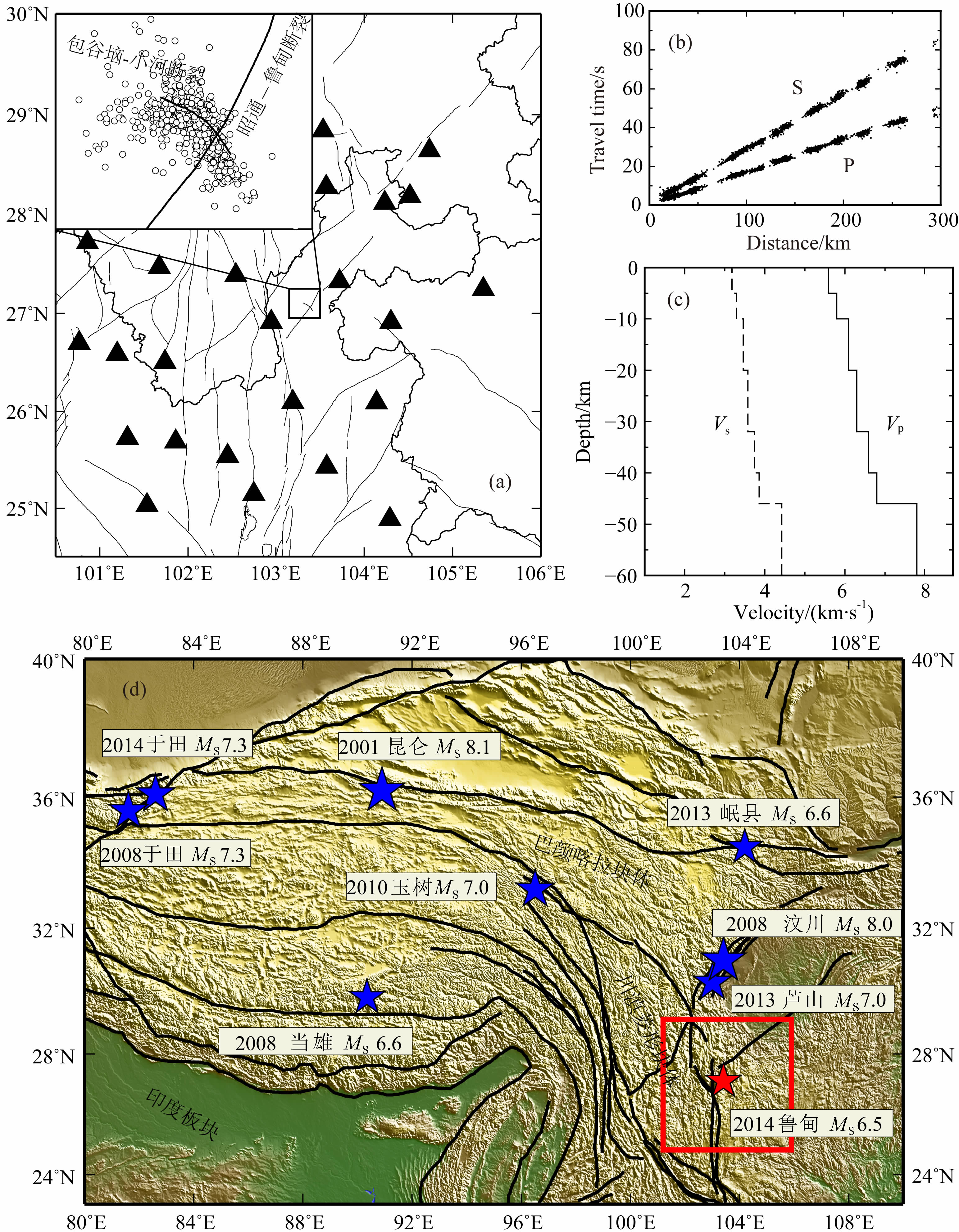 | 图 1(a)地震台站及本研究所用的初始地震震中分布;(b)P波和S波观测走时曲线;(c)速度模型;(d)近年来青藏高原及周边地区中强震活动与本次鲁甸MS6.5级分布,红色方框为研究区Fig. 1(a)Distribution of seismic stations and initial locations of earthquake epicenters used in the present study;(b)Observed travel time curves of P and S wave;(c)Velocity models used in the study;(d)Moderate-to-strong earthquakes occurred in recent years around Tibetan plateau and the present Ludian MS6.5 earthquake, and the red box represents the study area |
本研究重定位采用云南省地震局提供的2014年8月3日至7日共648个地震事件(图 1a)的观测资料,选择震中距小于300 km的到时,其中P波4344条、S波3615条(图 1b).参与定位的台站总共25个,可以看出围绕地震序列有着较好的空间分布(图 1a).震源机制反演采用云南和四川台网记录到的宽频带波形资料,我们挑选了M≥4.0级共5次地震事件的波形资料,其中震中距均在280 km以内.本研究地震重定位及震源机制反演所采用的一维速度模型如图 1c所示,该模型综合了前人的人工地震测深(白志明和王春镛,2003)和接收函数(李永华等,2009)等研究结果.
本研究采用双差定位法(Waldhauser and Ellsworth, 2000)对地震序列进行重定位,该方法使用相对走时残差来修定地震位置,因此能够减少速度模型不准确性对定位结果的影响.余震序列的双差定位结果,已被证明能够较好地反映断层破裂的延展范围如(黄媛等,2008; Lei et al., 2012,2014a; 张广伟等,2014).为获得高精度的定位结果,设定事件对的距离阀值相对较小,为4 km.
本研究采用gCAP(generalized Cut And Paste)方法求取震源机制解(Zhu and Ben-Zion, 2013).该方法通过对Pnl和S波(或面波)两部分赋予不同权重,计算理论和实际波形的拟合误差函数,采用网格搜索得到最小误差的最优解.反演中Pnl和S波滤 波范围分别为0.05~0.2 Hz和0.02~0.1 Hz,走向、倾角和滑动角的搜索间隔均为5°,深度为1 km.格林函数采用频率-波数法(FK)来计算(Zhu and Rivera, 2002),其中采样间隔设为0.1 s、采样点为1024个.
3 结果通过双差重定位,我们最终获得471个地震事件的重定位结果,其东西、南北及深度上平均相对误差分别为0.44 km、0.57 km和1.23 km.本次鲁甸 MS6.5级主震震源位置被重定为(103.37°E,27.08°N),深度13.3 km.图 2展示出余震序列分布的平面图和纵剖面图.从平面分布可以看出,地震呈现共轭型分布,优势分布方向为北西向,延展范围约22 km,且穿过了昭通—鲁甸断裂,而近东西向破裂长度相对较短,约17 km;且4.0级以上余震均集中在共轭交汇区(图 2a).由纵剖面可以清楚地看出,地震分布在26 km深度以上,优势深度集中在4~10 km之间(图 2b—2d),且北西向断层面较为陡立(图 2c).另外,我们还看到余震活动由主震处沿两个相互共轭的断层分别向南东和东西向扩展,且逐渐变浅(图 2b和2d).
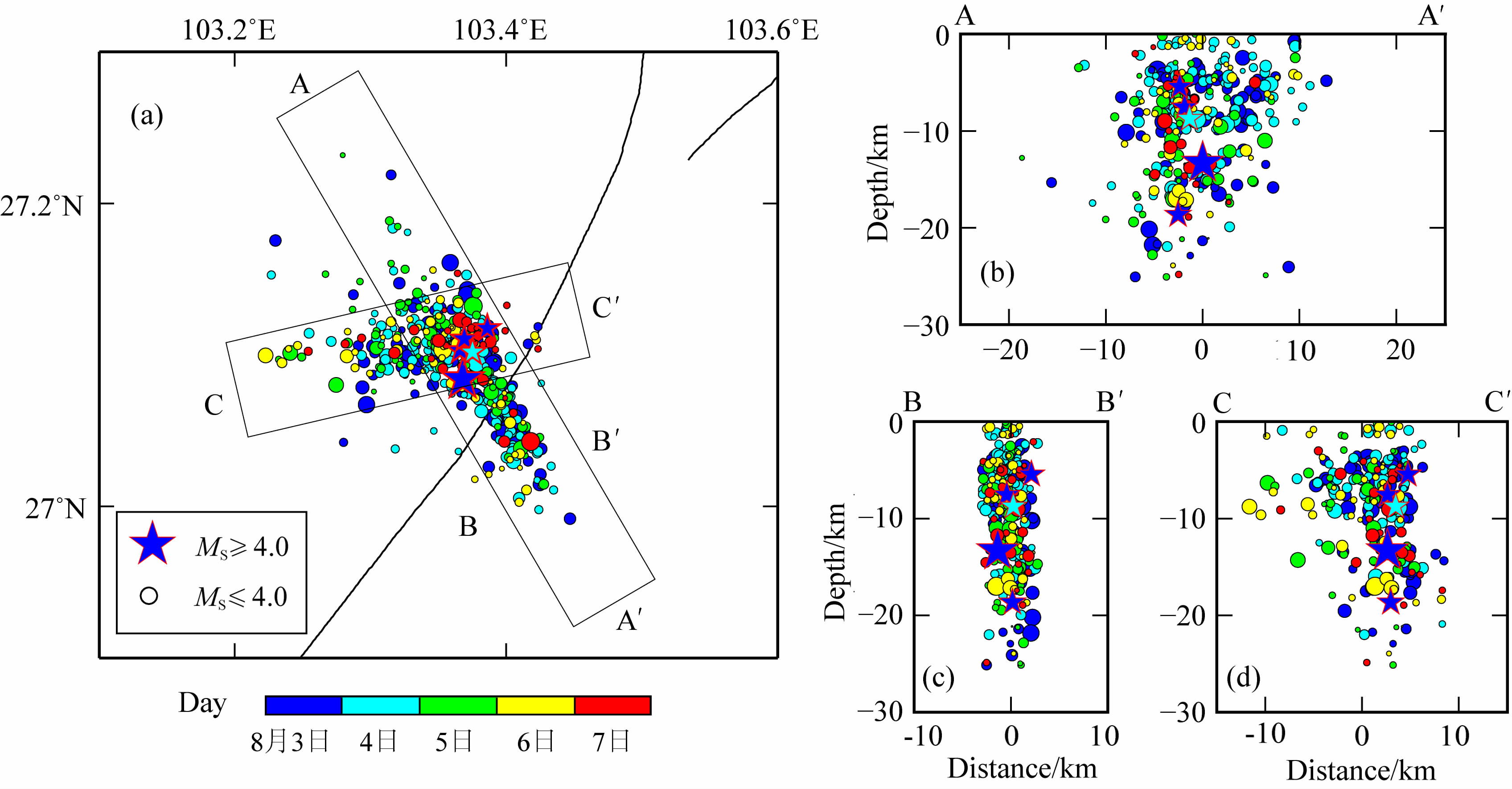 | 图 2 重定位后地震平面及深度剖面图BB′为垂直于AA′剖面,剖面比例均为1 ∶ 1,星号代表 4.0级及以上地震,圆圈代表 4.0级以下地震,星号与圆圈内的颜色代表不同的发震日期.Fig. 2 Map view and vertical cross sections of relocated earthquake sequenceBB′ profile is perpendicular to the AA′, and no vertical exaggerations in all three profiles. Stars denote big earthquakes with magnitude larger than and equal to 4.0,whereas circles denote small ones with magnitude less than 4.0. Colors in circles and stars denote different days of earthquakes. |
为了更好地展示余震的时空变化特征,我们按照不同时间段来展示余震分布情况(图 3).第一阶段为主震发生后0~5 h时间段,余震主要呈现出东西-南东方向双侧扩展模式,但为南东长、东西短的不对称双侧扩展模式,且震源多集中在浅部;第二阶段为主震发生后5~10 h时间段,余震多集中在共轭交汇区内,南东方向为主要扩展方向;第三阶段为主震发生后10~15 h时间段,该阶段余震数量已有明显减少,但在共轭两个方向均有分布,震源深度集中在10 km以上.为进一步了解是否主震发生引起了相互共轭的两个断层活动,我们将主震后1 h内地震在平面及深度上的分布展示出来(图 4),可以看出该时间段内尽管地震主要分布沿北西向展布,但仍存在少量近东西向的余震分布.
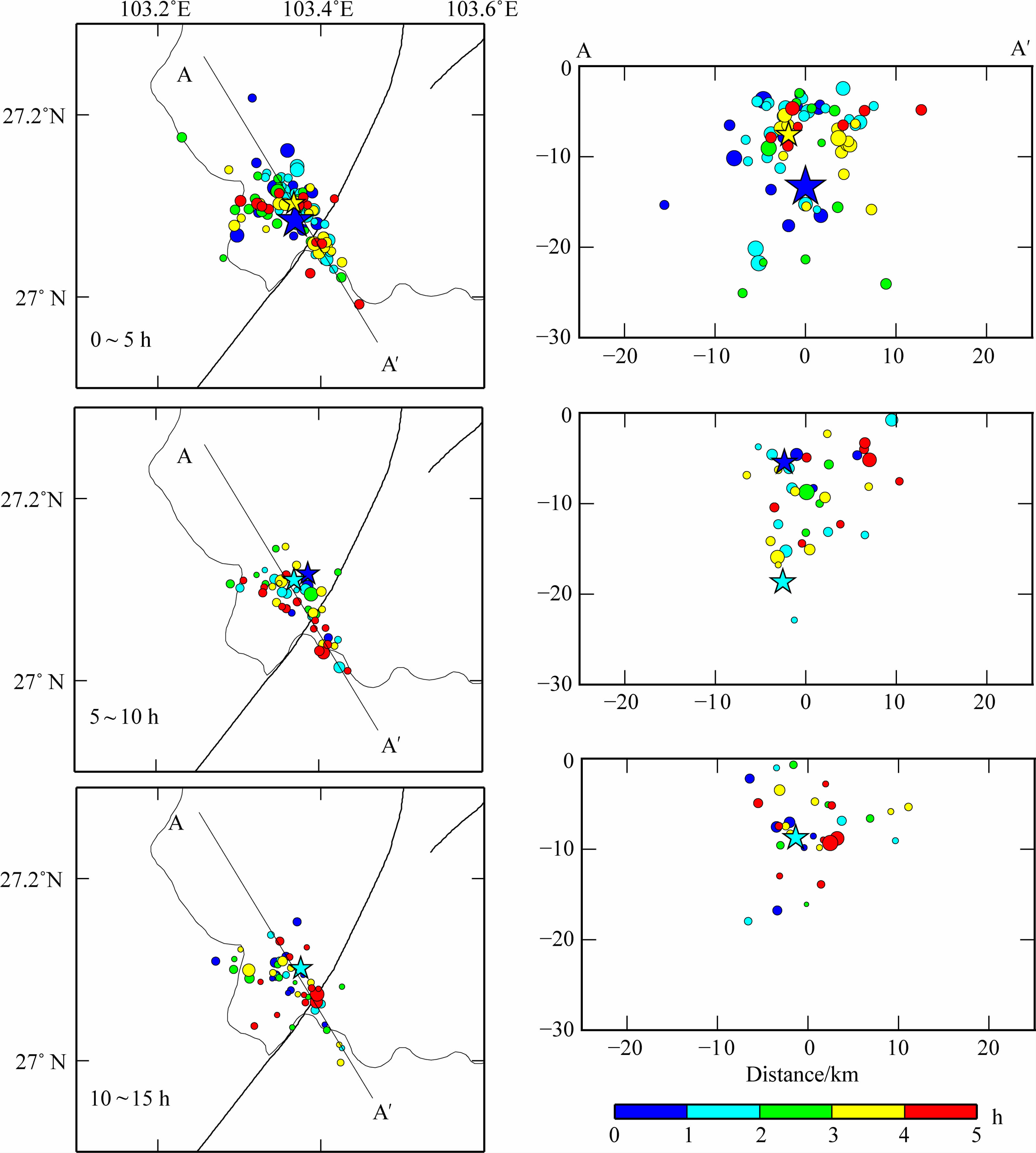 | 图 3 不同时间段地震平面及深度剖面图(不同颜色代表主震后每5h内相对时间)Fig. 3 Relocation earthquakes in map view and along cross section at different periods of time(Different colors denote relative times in every 5 hours after mianshock) |
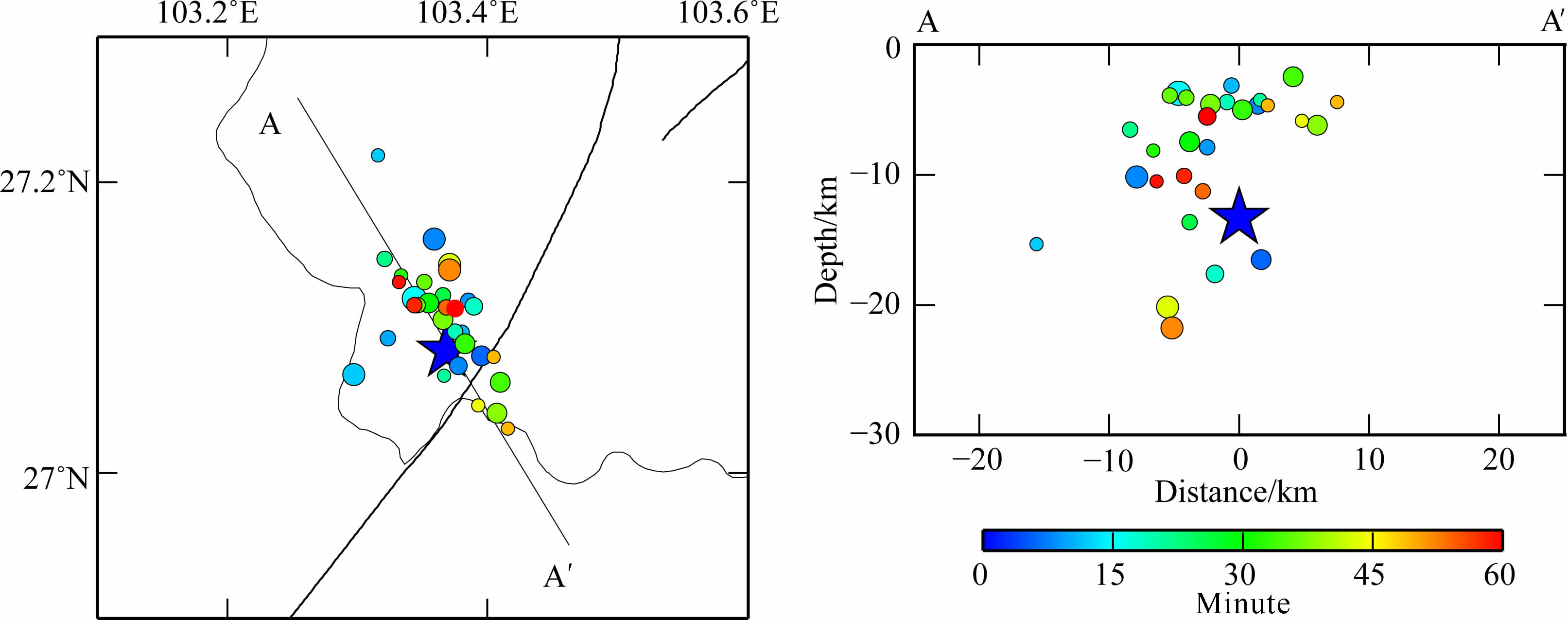 | 图 4 主震发生后1h内地震平面及深度纵剖面图星号代表主震,圆圈代表余震,颜色代表相对于主震后1 h内余震发生的时间序列.Fig. 4 The star denotes the mainshock,whereas circles denote aftershocks. Colors denote time sequence relative to the mainshock in an hour. The color scale is shown at the bottom. |
为深入探讨余震的扩展模式,本文将定位结果与主震破裂过程反演结果(郝金来1),图 5)相结合起来,可以看出主震产生破裂主要沿南东向扩展,这与沿该方向的余震分布特征相一致.双差定位主震的震源深度为13.3 km,处于破裂结果的底部,可能表征主震的初始破裂点位于该深度,但较大滑移量却位于浅部约2~8 km,这可能是此次地震造成严重灾害的重要原因.同时,余震集中分布在滑动量相对较小区域,特别是主震后4个4.0级以上余震均位于滑动量较小的共轭交汇区.
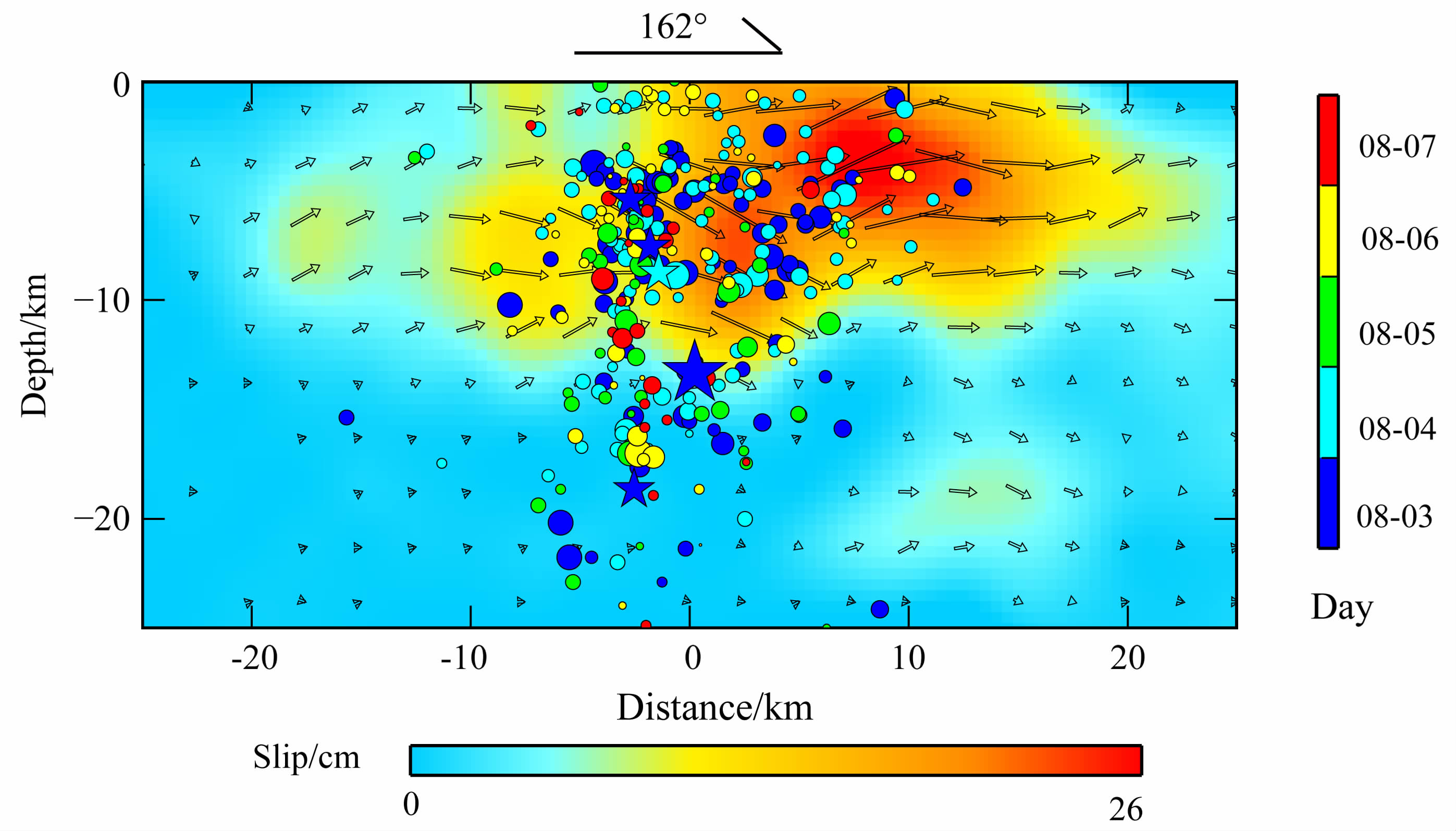 | 图 5 地震在破裂面上的投影及主震破裂滑动量分布(郝金来1))箭头指向代表滑移方向,箭头长度和背景颜色均代表滑移量,色标示于图底,星号代表主震及4.0级以上余震,圆圈代表余震,圆圈大小代表震级,圆圈内颜色代表发震日期,色标示于图右,与图 2一致.Fig. 5 Earthquakes projected on the fault plane and the slip distribution of main shockOrientation of arrows denotes the direction of slipping,whereas the length of arrows and background color denote slipping magnitude. The color scale is shown at the bottom. Stars denote earthquakes with magnitude of larger than or equal to 4.0. Circles denote aftershocks. The size of circles denotes earthquake magnitude,whereas the color in the circle denotes the date of earthquake occurrence. The color scale is shown on the right,which is same as in Fig. 2. |
采用gCAP方法,通过不同深度震源机制反演,得到主震的最佳质心深度为5 km(图 6).图 7给出5 km深度上主震震源机制解(下半球投影)以及理论和实际波形拟合图,可以看出所用波形段总共72个,其中相关系数在70%以上有66个,占总数的92%,说明整体上波形拟合效果较好、所获得的震源参数较为可信.然而,主震的最佳质心深度5 km与双差定位结果13.3 km相差约8 km.这样的差别,可能由于其所反映的震源深度概念不同的原因.双差定位结果所用资料为初至震相,因此通过其获得的震源深度反映的是震源初始破裂点,而震源机制 反演给出的深度却是破裂面的质心深度.主震破裂结果显示较大滑移量位于2~8 km,平均位置大约在5 km,与我们获得的震源机制解展示的质心深度具有较好的一致性.因此,由破裂过程与主余震空间分布关系(图 5)足以证实我们双差定位的主震震源深度和主震破裂面的质心深度均可信.表 1和图 8 给出4.0级以上地震的最佳拟合节面解,可以看出 5个4.0级以上地震的断层面倾角均较为陡立,但破裂面的走向存在明显差异.其中,8月3日21时MS4.0级余震的破裂面走向为近北西向,而其余3个余震的发震面走向为近东西向,且这3个余震的空间位置较为靠近,因此也证实了破裂面走向更为相近.另外,21时MS4.0级余震的破裂面走向更接近主震的北西走向.这两类不同的破裂面走向,均得到余震空间分布结果(图 2和图 3)的支持,因此我们认为本次鲁甸MS6.5级主震错断了互为共轭的两条断裂.这种具有不同错动方向的地震,可能为致灾严重原因之一.
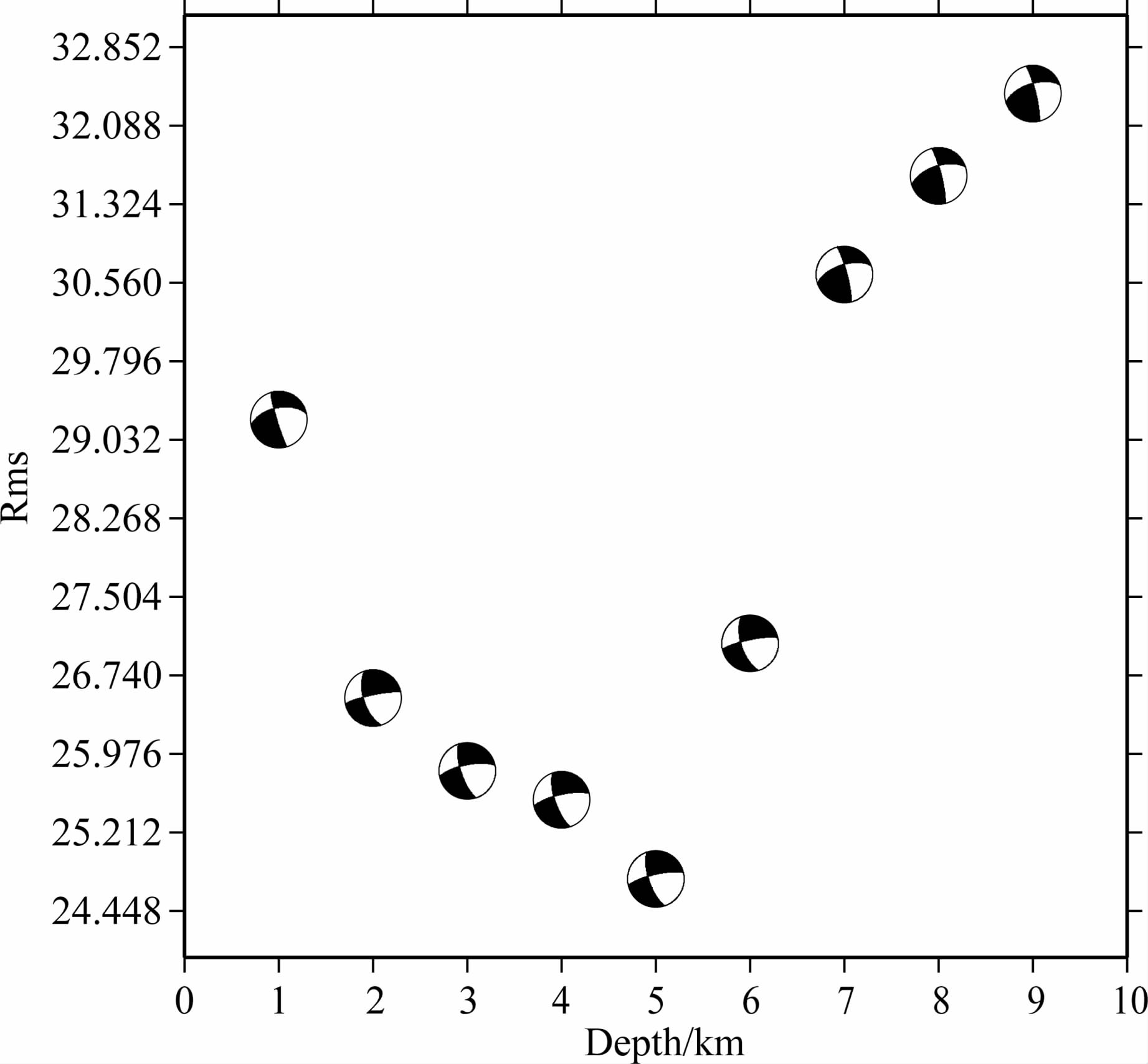 | 图 6 2014年8月3日MS6.5级主震不同深度上震源机制解及其反演方差Fig. 6 Focal mechanism solutions and rms of the 3 August 2014 MS6.5 mainshock at different depths |
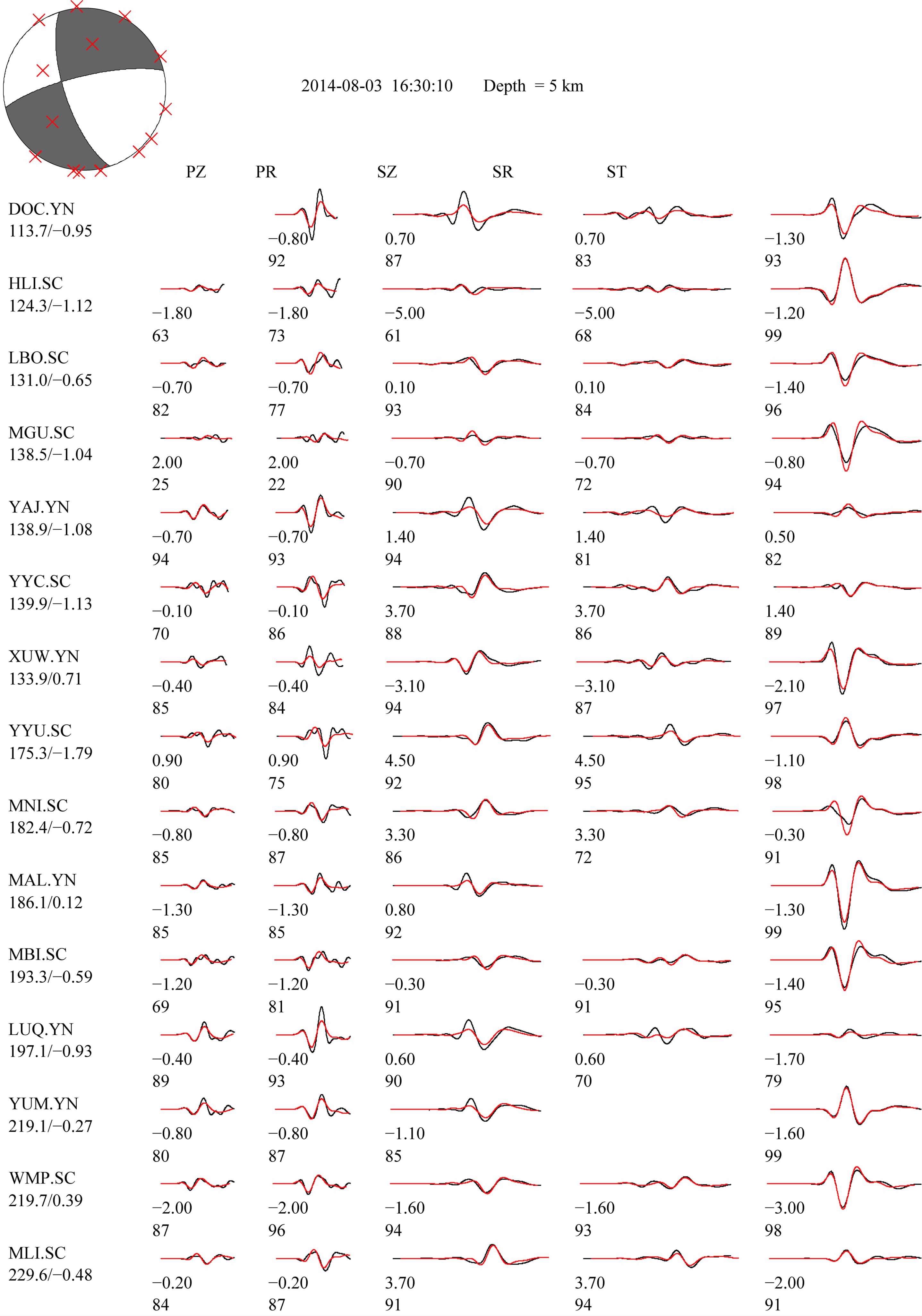 | 图 7 2014年8月3日MS6.5主震震源机制解及理论(红色)和实际(黑色)波形对比图波形下方数字表示理论相对实际波形的相对移动时间和二者的相关系数,左侧大写字母表示台站名,台站下方数字为震中距和相对偏移时间.Fig. 7 Focal mechanism solution and comparison between synthetic(red) and observed(black)waveforms of the 3 August 2014 MS6.5 mianshockThe numbers below each traces are relative time shift and cross-crelation coefficient. The station names are given on the left and the numbers below each station are epicentral distance and relative time shift. |
| 表 1 MS≥4.0地震震源机制解Table 1 Focal mechanism solutions of MS≥4.0 earthquakes |
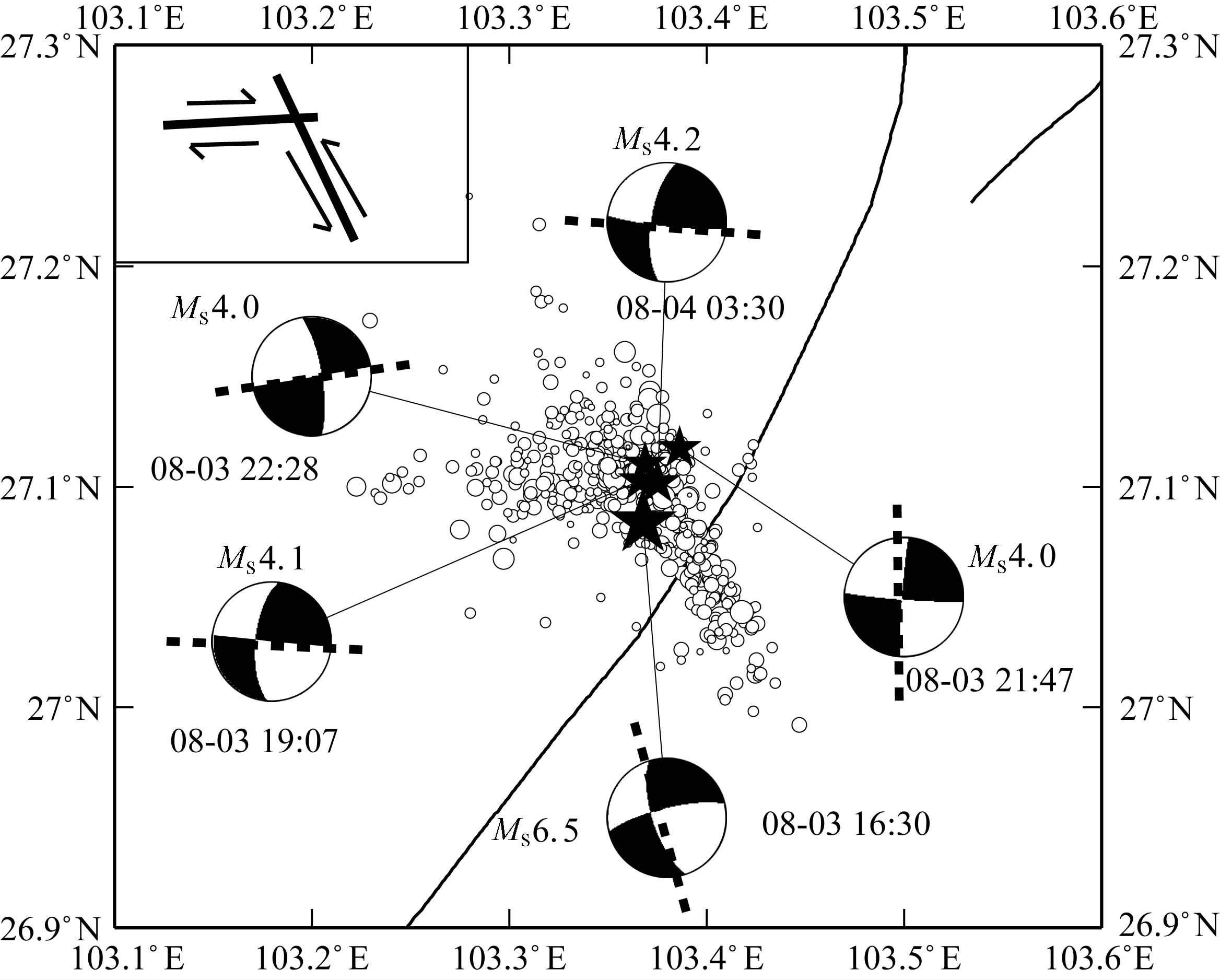 | 图 8 Ms≥4.0地震震源机制解及共轭破裂模型(黑色虚线代表可能的破裂面)Fig. 8 Focal mechanism solutions of the Ms≥4.0 earthquakes and the conjugate rupture model(The black dotted line represents the possible ruptre plane) |
采用双差定位法获得鲁甸MS6.5级地震序列471个事件的重定位结果.结果显示,主震初始破裂深度约13 km,余震主要沿北西方向分布,约22 km,其共轭方向破裂长度约17 km.由gCAP方法获得的结果显示,主震质心深度约5 km.这种共轭型破裂和质心深度较浅,可能为造成此次地震地表破坏较大的直接原因.类似的共轭型破裂地震还有2011 年3月10日云南盈江5.8级地震(Lei et al., 2012),该地震虽然震级在6.0以下,但也造成了25人死亡.结合余震空间分布特征及主震震源机制判断,鲁甸MS6.5 级是一次高倾角走滑型地震,发震断层为北西向包谷垴—小河断裂,是北东向昭通—鲁甸断裂系的北西向次级走滑断层,均属于小江断裂系(中国地震局地质研究所,2014).主震引起的断层破裂可能双侧扩展,但在北东向可能受到阻碍,从而产生了不对称的共轭破裂,且余震也主要集中在共轭交汇区,主震后发生的4个4.0级以上余震有1个破裂面走向与主震相同,而另外3个位于共轭方向.另外,余震多分布于主震破裂滑移量较小区域,可能 表明在主破裂区应力得到一定的释放,而在边缘容易产 生破裂引发余震(王卫民等,2005;赵翠萍等,2008).
此次鲁甸MS6.5级地震是云南地区2000年以 来震级最大地震,与围绕在巴颜喀拉块体周边的地 震分布明显不同.譬如,2014年于田MS7.3级地震(张广伟等,2014)发生在巴颜喀拉块体西边界的走滑型断裂带上,而本次鲁甸MS6.5级地震却发生在川滇菱形块体东边界的小江断裂带上.为此我们推测,由于印度板块与欧亚板块持续碰撞作用,引起青藏高原内部物质的东南向逃逸(Tapponnier et al., 1982; 邓起东等,2010;徐锡伟等,2011; Jia et al., 2012; Peng et al., 2012)和地 幔深部物质作用(如Lei et al., 2009,2013,2014b; 胥颐等,2013),巴颜喀拉块体的活动可能已转移至川滇菱形块体周边,从而导致此次地震的发生.
致谢 感谢F. Waldhauser提供双差定位程序,L. Zhu提供gCAP程序,中国地震台网中心提供观测报告数据及中科院地质与地球物理研究所郝金来博士提供震源破裂模型,感谢匿名审稿人对本文提出宝贵的修改意见.| [1] | Bai Z M, Wang C Y. 2003. Tomographic investigation of the upper crustal structure and seismotectonic environments in Yunnan province. Acta Seismologica Sinica (in Chinese), 25(2):117-127. |
| [2] | China Earthquake Administration. 2014a. 《The death toll rose to 589 people in the Yunnan Ludian earthquake》,http://www.cea.gov.cn/publish/dizhenj/468/553/100821/100827/20140806133429221861103 /index.html[2014-08-06]. |
| [3] | China Earthquake Administration. 2014b. 《961 aftershocks were recorded in the Yunnan Ludian M6.5 earthquake ended at 22 o'clock on Aug.7》, http://www.cea.gov.cn/publish/dizhenj /468/553/100821/100830/20140807221638020912347/index.html[2014-08-07]. |
| [4] | Deng Q D, Gao X, Chen G H, et al. 2010. Recent tectonic activity of Bayankala fault-block and the Kunlun-Wenchuan earthquake series of the Tibetan Plateau. Earth Science Frontiers (in Chinese), 174(5): 163-178. |
| [5] | Huang Y, Wu J P, Zhang T Z, et al. 2008. Relocation of the M8.0 Wenchuan earthquake and its aftershock sequence.Science in China (Series D), 51(12):1703-1711. |
| [6] | Institute of Geophysics, CEA. 2014. 《the 3 August 2014 Ludian, Yunnan MS6.5 earthquake》, http://www.cea-igp.ac.cn/tpxw/270724.shtml[2014-08-03]. |
| [7] | Institute of Geology, CEA. 2014. 《Study on seismogenic fault of the Ludian, Yunnan MS6.5 earthquake》, http://www.eq-igl.ac.cn/wwwroot/c_000000090001/d_1406.html[2014-08-06]. |
| [8] | Institute of Geology and Geophysics, CAS. 2014.《Preliminary result for Rupture Process of Aug. 3, 2014, MS6.5 Earthquake, Ludian, Yunnan》, http://www.igg.cas.cn/xwzx/kyjz/201408/t20140808_4172104.html[2014-08-08]. |
| [9] | Jia K, Zhou S Y, Wang R. 2012. Stress interactions within the strong earthquake sequence from 2001 to 2010 in the Bayankala block of eastern Tibet. Bull. Seismol. Soc. Am., 102(5): 2157-2164. |
| [10] | Lei J S, Zhao D P, Su Y J. 2009. Insight into the origin of the Tengchong intraplate volcano and seismotectonics in southwest China from local and teleseismic data. J. Geophys. Res., 114(B5): B05302, doi:10.1029/2008JB005881. |
| [11] | Lei J S, Zhang G W, Xie F R, et al. 2012. Relocation of the 10 March 2011 Yingjiang, China, earthquake sequence and its tectonic implications. Earthquake Science, 25(1): 103-110. |
| [12] | Lei J S, Xie F R, Fan Q C, et al. 2013. Seismic imaging of the deep structure under the Chinese volcanoes: An overview. Phys. Earth Planet. Inter., 224: 104-123. |
| [13] | Lei J S, Zhang G W, Xie F R. 2014a. The 20 April 2013 Lushan, Sichuan, mainshock, and its aftershock sequence: tectonic implications. Earthquake Science, 27(1): 15-25. |
| [14] | Lei J S, Li Y, Xie F R, et al. 2014b. Pn anisotropic tomography and dynamics under eastern Tibetan plateau. J. Geophys. Res.: Solid Earth, 119(3): 2174-2198. |
| [15] | Li Y H,W u Q J,Tian X B, et al. 2009. Crustal structure in the Yunnan region determined by modeling receiver functions.Chinese J.Geophys. (in Chinese), 52(1):67-80 |
| [16] | Peng Y, Zhou S Y, Zhuang J C, et al. 2012. An approach to detect the abnormal seismicity increase in Southwestern China triggered coseismically by 2004 Sumatra Mw9.2 earthquake. Geophys. J. Int., 189(3): 1734-1740. |
| [17] | Tapponnier P, Peltzer G, Le Dain A Y, et al. 1982. Propagating extrusion tectonics in Asia: New insights from simple experiments with plasticine. Geology, 10(12): 611-616. |
| [18] | Waldhauser F, Ellsworth W L. 2000. A double-difference earthquake location algorithm: method and application to the Northern Hayward Fault, California. Bull. Seismol. Soc. Am., 90(6): 1353-1368. |
| [19] | Wang W M, Li L, Zhao L F, et al. 2005. Rupture process of Jiashi, Xinjiang earthquake (MS6.5) of Feb. 24, 2003. Chinese J. Geophys. (in Chinese), 48(2): 343-351. |
| [20] | Wen X Z, Du F, Yi GX, et al. 2013. Earthquake potential of the Zhaotong and Lianfeng fault zones of the eastern Sichuan-Yunnan border region. Chinese J. Geophys. (in Chinese), 56(10): 3361-3372. |
| [21] | Xu X W, Tan X B, Wu G D, et al. 2011. Surface rupture features of the 2008 Yutian MS7.3 earthquake and its tectonic nature. Seismology and Geology (in Chinese), 33(2): 462-471. |
| [22] | Xu Y, Yang X T, Liu J H. 2013. Tomographic study of crustal velocity structures in the Yunnan region southwest China. Chinese J. Geophys. (in Chinese), 56(6): 1904-1914, doi: 10.6038/cjg20130613. |
| [23] | Zhang G W, Lei J S, Sun C Q. 2014. Relocation of the 12 February 2014 Yutian, Xinjiang, mainshock (MS7.3) and its aftershock sequence. Chinese J. Geophys. (in Chinese), 57(3): 1012-1020, doi: 10.6038/cjg20140330. |
| [24] | Zhao B, Gao Y, Huang Z B, et al. 2013. Double difference relocation, focal mechanism and stress inversion of Lushan MS7.0 earthquake sequence. Chinese J. Geophys. (in Chinese), 56(10): 3385-3395, doi: 10.6038/cjg20131014. |
| [25] | Zhao C P, Chen Z L, Zheng S H. 2008. Source rupture process of 3 Jiashi M6 events(1998—2003) and its correlation with the aftershock activity. Chinese J.Geophys. (in Chinese),51(4): 1093-1102. |
| [26] | Zhu L P, Ben-Zion Y. 2013. Parametrization of general seismic potency and moment tensors for source inversion of seismic waveform data. Geophys. J. Int. 194(2):839-843. |
| [27] | Zhu L P, Rivera L A. 2002. A note on the dynamic and static displacements from a point source in multilayered media. Geophys. J. Int. 148(3): 619-627. |
| [28] | 白志明,王春镛. 2003. 云南地区上部地壳结构和地震构造环境的层析成像研究. 地震学报,25(2): 117-127. |
| [29] | 邓起东, 高翔, 陈桂华等. 2010. 青藏高原昆仑—汶川地震系列与巴颜喀喇断块的最新活动. 地学前缘, 17(5): 163-178. |
| [30] | 黄媛,吴建平,张天中等.2008. 汶川8.0级大地震及其余震序列重定位研究.中国科学(D辑),38(10): 1242-1249. |
| [31] | 李永华,吴庆举,田小波等. 2009. 用接收函数方法研究云南及其邻区地壳上地幔结构.地球物理学报,52(1): 67-80. |
| [32] | 王卫民, 李丽, 赵连锋等. 2005. 2003年2月24日新疆伽师MS6.5级地震震源破裂过程研究. 地球物理学报, 48(2): 343-351. |
| [33] | 闻学泽, 杜方, 易桂喜等. 2013. 川滇交界东段昭通、莲峰断裂带的地震危险背景. 地球物理学报, 56(10): 3361-3372. |
| [34] | 徐锡伟, 谭锡斌, 吴国栋等. 2011. 2008年于田MS7.3地震地表破裂带特征及其构造属性讨论. 地震地质, 33(2): 462-471. |
| [35] | 胥颐, 杨晓涛, 刘建华. 2013.云南地区地壳速度结构的层析成像研究.地球物理学报, 56(6): 1904-1914, doi: 10.6038/cjg20130613. |
| [36] | 赵博, 高原, 黄志斌等. 2013. 四川芦山MS7.0地震余震序列双差定位、震源机制及应力场反演. 地球物理学报, 56(10): 3385-3395, doi: 10.6038/cjg20131014. |
| [37] | 赵翠萍,陈章立,郑斯华.2008. 1998—2003年伽师三次不同类型MS6级地震震源破裂过程及短期内余震活动特征.地球物理学报, 51(4): 1093-1102. |
| [38] | 张广伟, 雷建设, 孙长青. 2014. 2014年2月12日新疆于田MS7.3级地震主震及余震序列重定位研究. 地球物理学报, 57(3): 1012-1020, doi: 10.6038/cjg20140330. |
| [39] |
中国地震局. 2014a.《云南鲁甸地震遇难人数增至589人》,http://www.cea.gov.cn/publish/dizhenj/468/553/100821 /100827/20140806133429221861103/index.html [2014-08-06]. |
| [40] |
中国地震局. 2014b.《截至8月7日22时00分 云南鲁甸6.5级地震共记录到余震961次》,http://www.cea.gov.cn/publish/dizhenj/468/553/100821/ 100830/20140807221638020912347/index.html[2014-08-07]. |
| [41] | 中国地震局地球物理研究所. 2014. 《2014年8月3日云南鲁甸6.5级地震》, http://www.cea-igp.ac.cn/tpxw/270724.shtml[2014-08-03]. |
| [42] | 中国地震局地质研究所. 2014. 《云南鲁甸6.5级地震发震断层分析》,http://www.eq-igl.ac.cn/wwwroot/c_000000090001/d_1406.html[2014-08-06]. |
| [43] | 中国科学院地质与地球物理研究所. 2014. 《2014年8月3日云南鲁甸MS6.5级地震震源破裂过程反演初步结果》,http://www.igg.cas.cn/xwzx/kyjz/201408/ t20140808_4172104.html[2014-08-08]. |
 2014, Vol. 57
2014, Vol. 57


